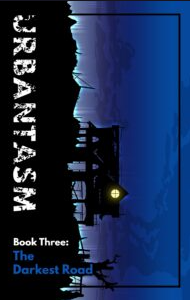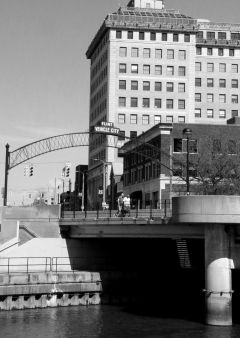By Robert Thomas
Urbantasm is categorized as a magical teen noir serial novel composed of four books. The Darkest Road is Book Three of the series created by Flint writer Connor Coyne. But it is much more than a teen novel. It is a massive creation from Coyne’s omnivorous mind, and an often gripping evocation of the throes of a struggling city.
Having reviewed the first two books for East Village Magazine The Dying City (EVM July 2, 2018) and The Empty Room (EVM September 20, 2019), I awaited the Book Three episode like a kid with a puzzle box in which one box of stories propagates another box of surprises.
Coyne’s epic serial novel is an allegorical tale set in his fictional Rust Belt town of Akawe, Michigan — strangely and hauntingly like Flint — in the 1990s. The first two books set the stage upon which the characters dwell.
While coated in rusting post-industrial decay. Akawe is The Dying City and The Empty Room with The Darkest Road. Akawe is also inhabited by real people. The humanity of Coyne’s characters grows as their plight darkens.

Coyne’s third book in the triology Urbantasm, The Darkest Road. (Photo source: www.urbantasm.com/the-darkest-road)
In Book One, the characters were entering junior high school; in Book Three they are entering high school. They have been scattered throughout the city’s four high schools according to district.
In Book One, John began his narration with “I have to become the Antichrist.” The page fills with John’s multiple grudges against God, concluding with: “If I wanted to save my friends, I would have to murder God.”
The Darkest Road accentuates the noir element of Coyne’s tale as it opens with a ghastly murder. As I dipped into muddier waters with John Bridge, the narrator of this fable, and his band of friends as they wrestle with the shifting realities of time and space and the horrors of evil in a decaying city aboard a plundered planet skippered by a ship of fools, Leonard Cohen’s song “So You Want It Darker”came to mind.
In Book Three, John confronts God, urbantasms — loosely translated as “blue ghosts” — and a mysterious drug known as O-Sugar as he takes a long walk along Akawe’s darkest road. Long disorienting walks at night through the decay of Akawe is a trope in all three books. The Darkest Road walk is a doozy display, swarming with shape-shifting illuminations on a dark frozen night in Akawe.
Musical influences inform Coyne’s jazzy, bluesy writing rhythms and style. As John puts it in the early pages of Book Three: “I had always admired my father’s jazz music because it was all of history spread out through dancing sounds, shuttling blues.”
Urbantasm’s blue ghosts of the past, present, and future meld into a shape-shifting kaleidoscope of Akawe’s realities via Coyne’s word play. The snappy, snarky runs of dialogue coupled with John’s narrative voice continues to palpitate the pudding of this serial story box.
As John’s world swirls off into the unknown unknowns of reality, Miss Pavilik’s astronomy class offers him an introduction to the current state of cosmology in which the universe is being driven by an unknown called phantom energy.
“The expansion of the universe is accelerating,” she told her students, “and what’s more, the rate of acceleration is accelerating.”
“What’s gonna happen?” John asks.
What’s gonna happen is something called The Big Rip, which Miss Pavilik describes in answer to John’s question.

“The universe will expand more and more quickly. Galaxies will be blasted into pieces by the expanding spaces between them. Our solar system will be scattered as the planets are sucked so far from the sun that its gravitational pull makes no difference. Finally, structures, molecules, atoms, and electrons and protons will be drawn away from each other; a sequence of increasingly disintegrating smaller particles. The whole universe will be dissolved to elementary particles, and those particles will dissolve as well.”
For John the Big Rip is a horror story. Everything from the universe to his deteriorating life in Akawe is falling apart at an accelerating rate. He ponders eternal verities and their mysteries.
“I also wondered,” he narrates,“ how I felt about a God who would create a life-sustaining universe only to suddenly explode it, to rip it apart, just as life had finally arrived at its full burgeoning.”
Cosmological awakening collides with a deadly public water poisoning caused by political policy and perpetrated by a complete failure of hierarchical leadership from local, state, and federal authorities.
Coyne’s injection of Flint’s recent municipal water poisoning into the decay of Flint in the 1990s of John’s Akawe is an example of an urbantasm whereby the past, present, and future conflate and expand to expose gritty nubbins. Akawe is not the Land of Oz, the Hobbits, or Harry Potter. It is certainly not the Disneyland of the ethereal American Dream
The problem between Fantasyland and Reality World is an existential reality that confronts John and his mates at every turn along the darkest road in Akawe. Urbantasm is a fantastical fable firmly grounded in shape-shifting realities like the universe and Akawe, both as real as real can get.
The Darkest Road offers significant occultation and illumination—key components of imaginative fiction, whose rewards are rich in the mysterious wisdoms of reality as it expands, accelerates, and erupts around John and his friends like mortar rounds of shock-and-awe illuminations shaded in the blue ghosts of urbantasms composed of past, present, and future.
In search of further illumination, John meets Drake, the original O-Sugar candyman in Book One who took his band to the roof of the St. Christopher hospital for an O-Sugar flight off the roof to the parking lot below. Drake was the only survivor, albeit paralyzed and confined to a wheel chair. He and John share a mutual learning question: What is the magic ingredient in O-Sugar that would cause one to teleport off a rooftop? Drake knows what that felt like; John seeks to find out. To do so, he takes three hits of O-Sugar to accompany his long walk along Akawe’s darkest road. The journey is filled with urbantasms and awakenings. John now knows what Drake felt, but it is his cousin Michael who puts all the pieces together to solve the riddle of O-Sugar’s magic ingredient and its connection to the inexplicable hallucinations John and his friend Selby had shared at four years old.
John Bridge concludes The Darkest Road with an ecstatic prayer of hope which reminded me of crossroads blues and “Sympathy for the Devil.”
I was reminded of his two initial journal entries prompted by two questions: Where Did You Begin? and Where Are You Now?
To the first John wrote: “Akawe, Michigan. 1980. Time is travel and loss is learning.”
To the second he wrote: “Akawe, Michigan. We have bottles of water to drink and wash with. My house is warm. My mother still has her job, so we still have food to eat and a place to live. I got gifts for Christmas and I love them. I have friends though I haven’t seen them much. Adam and Nova and Selby and Quantla. Michael, especially. I need to just be here right now and to be grateful for what I have.”
Shortly after reading Book Three, I stumbled upon a book titled Allegorizings, by the great Welsh writer, traveler, adventurer, scholar Jan Morris. The book is a posthumous message from Morris that everything is an allegory; nothing is what it seems.

Connor Coyne (photo by Shane Gramling)
Urbantasm is much more than a teen novel; it is an epic serial allegory.
The Darkest Road, Book Three of Connor Coyne’s epic four-volume fable will be available September, 2021. More information about the upcoming book can be found at the link www.urbantasm.com/the-darkest-road.
EVM emeritus board member and frequent book reviewer Robert Thomas can be reached at capnz13prod@gmail.com.


You must be logged in to post a comment.